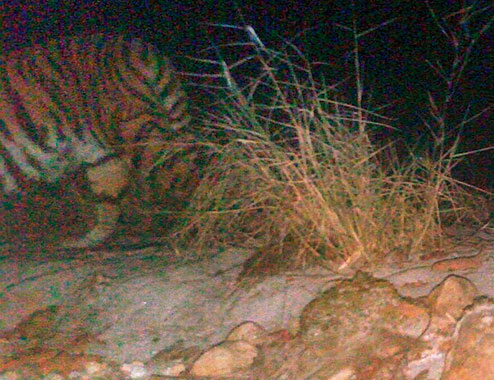SPOTTED: The year 2014 has begun on a positive note for the tiger population in the country as wildlife biologists have documented the first evidence of the big cats actually living in the Dibang Wildlife Sanctuary in Arunachal Pradesh. The evidence includes an image of a tiger, and also various pugmarks and scat samples collected from a rugged mountain zone in the northeastern state.
The image, which was captured near a riverbed by a remotely operated, tree-mounted automatic infrared camera on January 2 at around 3 A.M., shows what appears to be an adult tiger moving about in the high-altitude sanctuary. Members of the local Idu Mishmi community have long claimed that the sanctuary was home to tigers, but until the present evidence came forward the Wildlife Institute of India (WII) couldn’t confirm the presence of the big cats in the state.
The WII team had placed nine infrared cameras at strategic points in the sanctuary. The wildlife biologists, accompanied by a few members of the local community, covered nearly 120 km on foot and collected 11 samples of tiger scat and also documented nine tiger pugmarks. The scat samples have been sent to the WII for further study to learn about the diet of the tigers in the sanctuary.

Tiger watch
Scientists from WII, Dehradun, with the support of the Arunachal Pradesh government and the National Tiger Conservation Authority, had begun combing the sanctuary in December last year in order to confirm the presence of tigers in the area after two tiger cubs were found trapped in a dried well in a place called Angrim Valley just outside the sanctuary a year ago in December 2012. The cubs have since been relocated to the zoo in the state capital, Itanagar.
“The local communities have reported the presence of tigers in the area for decades,” said Govindan Veeraswami Gopi, a WII scientist involved in the recent search activity. “The discovery of the cubs was just another hint,” added Gopi.
Gopi further said that initially the WII wasn’t certain that the cubs were Royal Bengal tigers. Since the northern part of the Dibang Sanctuary lay along the Chinese border, there was a possibility that any tigers in the area could be members of the northern Indo-Chinese tiger population – a subspecies of the tiger family that lives across the border. However, genetic analysis of the cubs’ blood samples have confirmed that the cubs were indeed Royal Bengal tigers.
The tiger census in 2010 documented 1,706 big cats in the country that are scattered across 17 different states with tiger ranges. While the Namdapha and Pakke reserves in Arunachal Pradesh have documented the tigers before, both these areas are relatively low-altitude Himalayan forests.
In comparison, the tiger that was recently caught on camera in Dibang was found at an altitude of 1,765 meters above sea level. Gopi added that the search team had also collected scat samples from about 2,065 meters. While it is unusual to find the Royal Bengal tiger at such high altitudes, there have been confirmed reports of these big cats living at 4,100 meters in Bhutan.
The Idu Mishmi community appears to have long co-existed with tiger populations, and as such the tigers do not face any threat from the locals as they look up to the big cat as their elder brother.
More Related Stories,
Three Tiger Cubs Seen at Ranthambore
39 Tigers Fell Prey to Poachers in 2013
Sunderban Tigers Closely Related to Tigers from Madhya Pradesh
Image via cc/Flickr by Paul Mannix










One thought on “Royal Bengal Tiger makes Dibang Wildlife Sanctuary its Home”